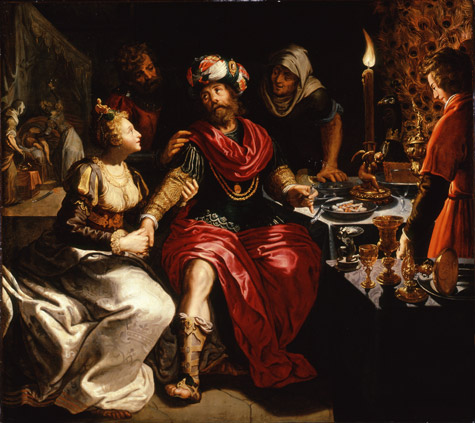
‘THE BANQUET OF HOLOFERNES’ Oil on canvas, 53.75x58.75 inches, by Kaspar van den Hoecke, ca 1615. |
"Objects of Wonder" is a mixed bag of a show, which is what it sets out to be. It's at the Portland Museum, where it's making its first stop on a national tour originating at the Norton Museum in Palm Beach. Much of it is easy to like because it reaches back to a simpler time when painting was more about the subject painted than about the work itself. Then little by little it introduces works that have more to say about the artist than the subject, bringing the view to a more contemporary sensibility.
Still life can be like that. It's a genre that lends itself to being decorative. Indeed, there was a discussion within my hearing (what, by the way, ever happened to the idea that one should be relatively quiet in a museum?) about how one work would go with another in a room at home. The show is divided by subject — here it's Natura Morta, there it's flowers, and over there, fruits and vegetables, and again, table-top arrangements and three-dimensional work.
The Natura Morta, or Still Life, is about dead stuff, or, in the case of the large 17th-century Flemish painting "The Banquet of Holofernes," about to be. The main character is being plied by Judith with strong drink, prior to removing his head. There's a vignette in the corner of the work depicting the upcoming surgery, in case the viewer has forgotten the biblical account.
Sharing the same theme is a 17th-century trompe l'oeil painting by Jacobus Biltius with a dead bird and other objects hanging against a white wall. An odd, incomplete-feeling Matisse from 1920 shows two dead rays on a beach, while the dead fish in Hartley's "Flounders and Bluefish" doubtless have some elegiac and iconographic purpose.
The "Flowers" section teases meanings from its arrangements in very different ways. The careful rendering in the garland by the 17th-century Flemish artist Daniel Seghers was meant to be a study aid in disciplined Catholic teaching, a tool for the counter-reformation.
Matisse's "The Rose" (1905) has a wondrous clunky quality that makes it simply stand there and will you to see it. Not far away there's an unusual, and late, Max Beckmann "Still Life with Blue Iris" (1948), in which the lugubrious black lines characteristic of Beckmann's style give the flowers an uncompromising demand for attention. If I could choose two paintings for my own home décor, it would be these two. No question.
There's a large Courbet in the "Fruits and Vegetables" section, "Still Life" (1871), in which he renders the fruits as objects of lascivious attention. The "Table-Top" section has a few remarkable works, including a fascinating 17th-century Dutch genre sill life by Christiaen Striep. Picasso's "La Guitare" embodies the artist's flamboyance with just a few lines and shapes.
The three-dimensional section has a life-size fish skeleton carefully carved by Fumio Yoshimura, "Grouper," marvelous for its technique. A tiny Ming dynasty tomb model of dishes with food for the afterlife makes one wish to eat.